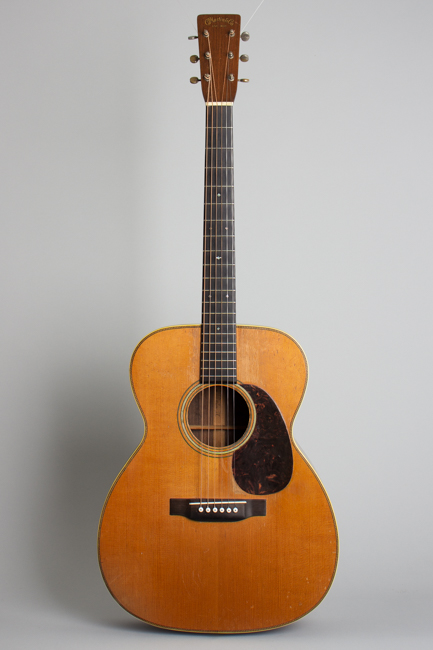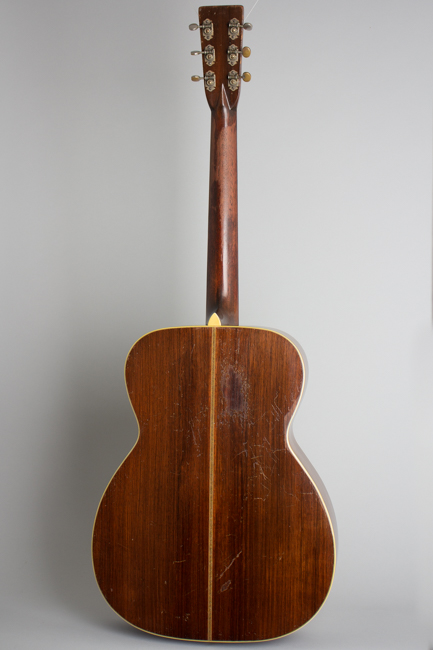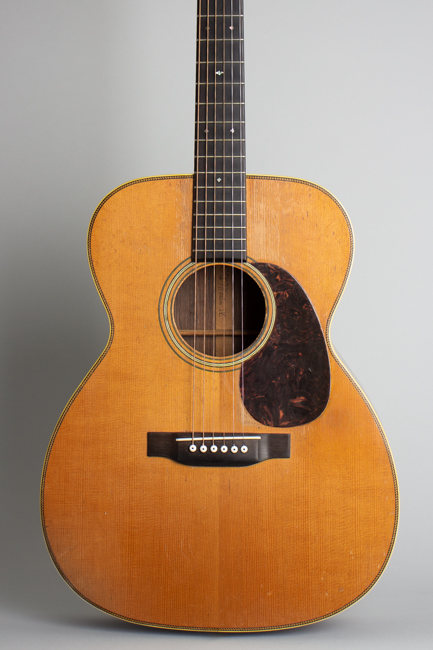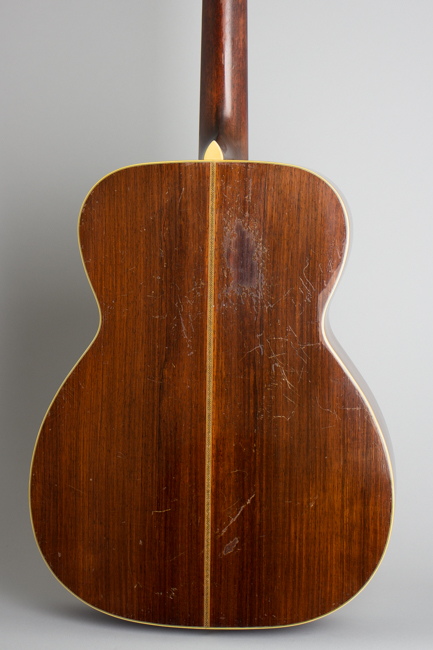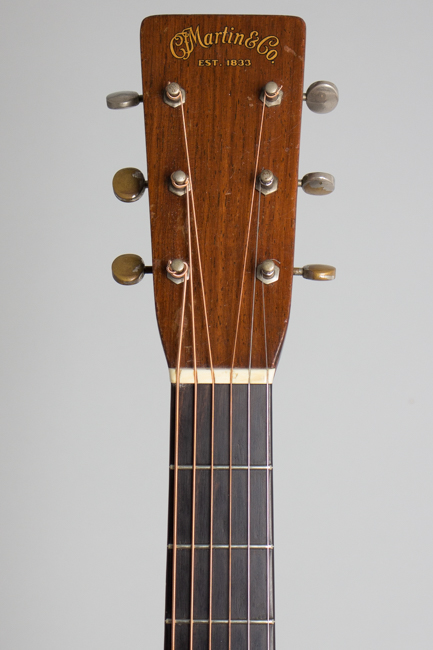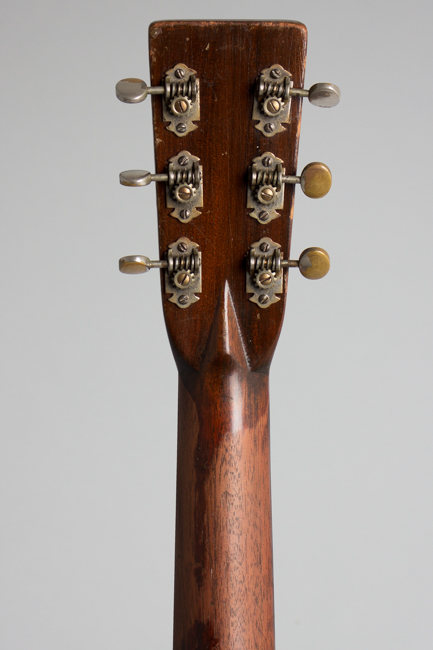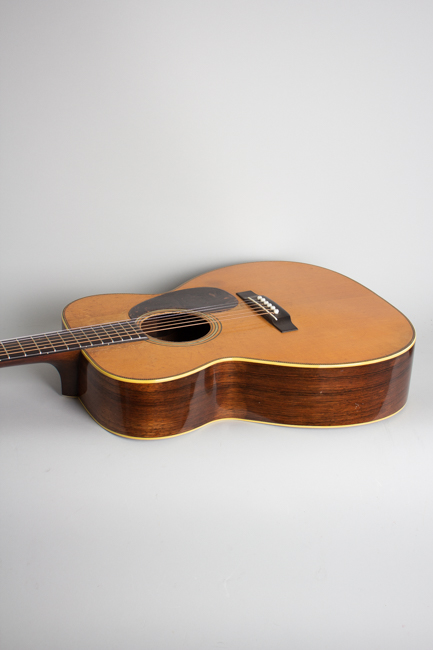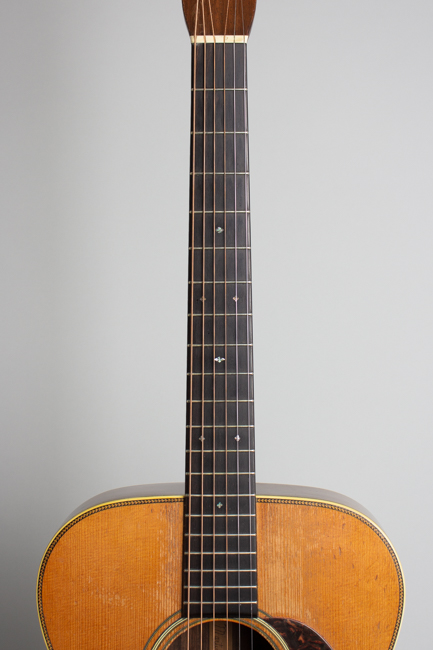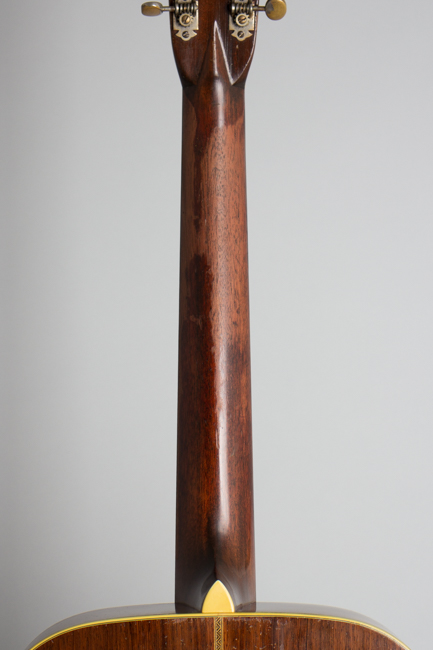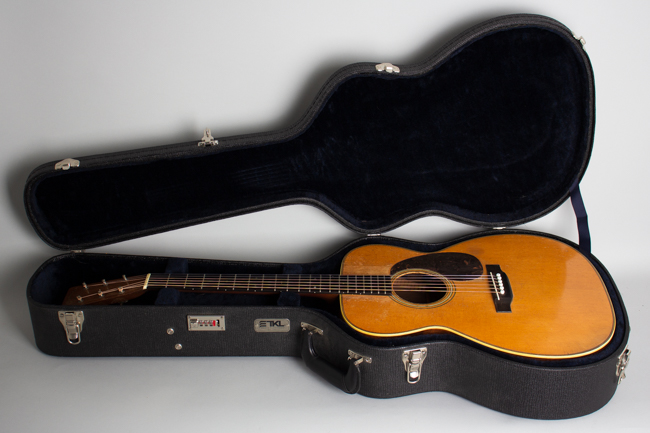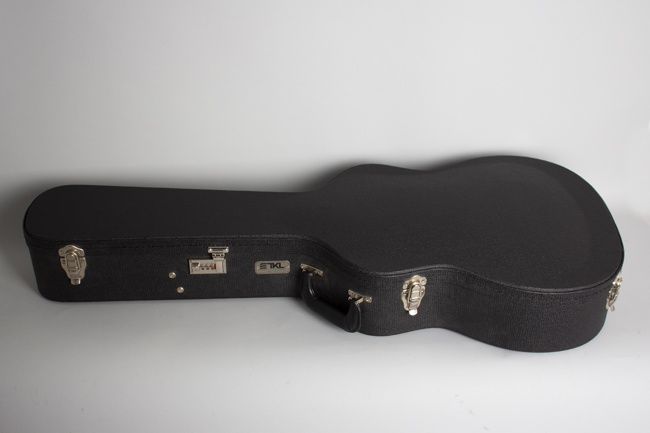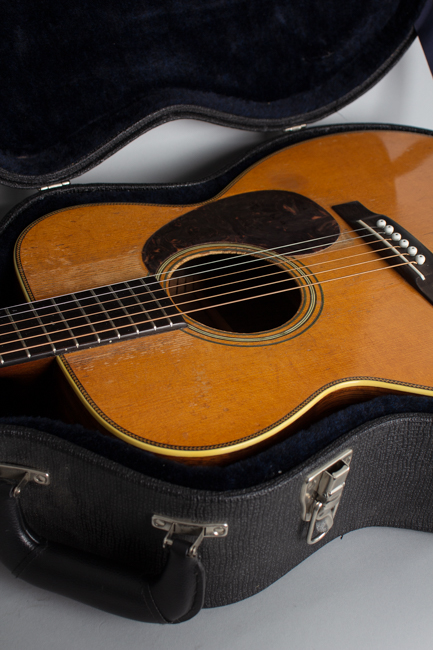C. F. Martin 000-28 Flat Top Acoustic Guitar (1942)
End of Summer Sale - PRICE REDUCED!
This item has been sold.
Item # 10600
Prices subject to change without notice.
C. F. Martin 000-28 Model Flat Top Acoustic Guitar (1942), made in Nazareth, PA, serial # 80682, natural lacquer finish, Brazilian rosewood back and sides, spruce top; mahogany neck with ebony fingerboard, black hard shell case.
This is a well-played but still superb original just-wartime Martin 000-28 made early in 1942; at this point the changes WWII would bring to Martin instruments were still in the future. This example would have shipped out not long after the beginning of the year, just as the US was starting to shift to wartime footing.
The 14 fret "herringbone" 000-28 is to some players the perfect flat-top guitar, simply the standard by which others are judged. The best Martins of this period are to many still unmatched for sound quality, even 80 years along. The 15" wide narrow-waisted body is just over 1/2" smaller than a Dreadnought and so yields a somewhat more focused midrange sound, with a less dominant bass response. The lightly scallop-braced top is extremely responsive, offering considerable power and depth when pushed combined with sweetness, sparkle, and a singing character when played more softly. The scale is slightly shorter than the earlier 1930s OM model which makes the action a bit more supple.
This 000 shows classic pre-war appointments, widely imitated ever since. The back and sides are Brazilian rosewood with the lovely even straight-grain figure Martin prized. The top is very tight-grained Appalachian red spruce, bordered with the famous "herringbone" wood trim that defines the Style 28 models bound on the outside with ivory celluloid. The back is triple-bound in celluloid with a zip-zag pattern backstrip. Other features include the 1930s-style long-saddle ebony bridge, multiple celluloid sound hole rings and a dark brown tortoise celluloid pickguard.
The neck is mahogany with an unbound ebony fingerboard decorated with discreet slotted diamond pearl inlay. The neck retains the pre-war steel "T" bar truss rod, unlike later wartime examples which substitute an ebony reinforcement. The peghead is faced in straight grained Brazilian rosewood with the gold "C.F. Martin & Co." decal at the top. The neck profile is round backed with a hint of a "V" in the way the sides bear away from the center as it moves towards the headstock. The nut is the then recently introduced 1 11/16" width, slightly narrower than the 1 3/4" standard in the mid-'30s. The early Waverly individual openback tuners have "ice cream cone" baseplates and nickel plated buttons, and are still intact and functional after decades of use.
While always a popular and well-respected instrument, rosewood 000s from this period are far from common guitars. Only 48 000-28s were produced in 1942, an astoundingly small total by modern standards. War time economics made this $110 guitar (without case) a reach to many; perhaps more important his price was only $10 less than the D-28 Dreadnought that had become Martin's most desired professional model.
These guitars were often working instruments for professionals, played into open mikes at radio studios and barn dance stages. Many Cowboy and Country and Western performers found large-body Martins the best instruments available for this rough-and-tumble world where guitars could be literally "played into the ground". Although this is mostly just a memory in the 21st century, this original 000-28 still plays effortlessly with the smooth and powerful sound typical of original "Golden Age" Martin guitars, perfect for a wide range of styles vintage or contemporary. A fantastic recording guitar, it mixes the mellow depth of a rosewood body with the instant ring of a lightly scallop-braced top. While heavily used it has been expertly maintained and is ready for many more decades of use. A beautiful guitar to behold and to hold, this 000-28 a true joy to play and a significant piece of flat-top history.
Overall length is 39 3/4 in. (101 cm.), 15 1/8 in. (38.4 cm.) wide at lower bout, and 4 1/8 in. (10.5 cm.) in depth at side, taken at the end block. Scale length is 24 3/4 in. (629 mm.). Width of nut is 1 11/16 in. (43 mm.).
Overall this is a lovely example, showing general wear and tear but considerably more original and better preserved than many of these often hard-worked guitars. The finish shows dings, dents and scrapes overall, with areas of finish loss from picking around the lower sound hole rim next to the fingerboard extension, in between the pickguard and bridge and in the 'buckle rash' position on the back and the back of the neck. There is no apparent overspray to the thin original lacquer and the guitar blacklights cleanly.
There are two small tightly sealed cracks in the soundhole rosette, one by the low 'E' string off the fingerboard extension and one similarly placed off the high 'E' string; neither of them extend beyond the rosette. On the bass side rim, there is a two inch repaired crack between the waist and the apex of the lower bout. On the back, there is a short one inch crack right at the waist on the bass side.
The neck has been very neatly reset, with the fingerboard trued and perfectly refretted with period correct wire. The bridge has been replaced with an excellent replica. There are a few small pulls and marks around the bridge from when it was removed long ago. Internally this guitar is very clean, including all the bracing which remains original and undisturbed. The bridge plate has been replaced, the new bridge plate has a slightly larger footprint than the original, but was very carefully made and appears to be correctly tucked in to the X-brace, just as an original would be.
While not a cosmetically perfect example, this rosewood 000 is in considerably more original condition than many of this period, and a perfect player with the fantastic sound one would expect. The often heavily used prewar Martin guitars of this type are hard to find in anything like original condition. This beautiful survivor is full of great songs and stories it could tell, just waiting to be coaxed out. It is housed in a well fitted modern HSC. Very Good + Condition.
This is a well-played but still superb original just-wartime Martin 000-28 made early in 1942; at this point the changes WWII would bring to Martin instruments were still in the future. This example would have shipped out not long after the beginning of the year, just as the US was starting to shift to wartime footing.
The 14 fret "herringbone" 000-28 is to some players the perfect flat-top guitar, simply the standard by which others are judged. The best Martins of this period are to many still unmatched for sound quality, even 80 years along. The 15" wide narrow-waisted body is just over 1/2" smaller than a Dreadnought and so yields a somewhat more focused midrange sound, with a less dominant bass response. The lightly scallop-braced top is extremely responsive, offering considerable power and depth when pushed combined with sweetness, sparkle, and a singing character when played more softly. The scale is slightly shorter than the earlier 1930s OM model which makes the action a bit more supple.
This 000 shows classic pre-war appointments, widely imitated ever since. The back and sides are Brazilian rosewood with the lovely even straight-grain figure Martin prized. The top is very tight-grained Appalachian red spruce, bordered with the famous "herringbone" wood trim that defines the Style 28 models bound on the outside with ivory celluloid. The back is triple-bound in celluloid with a zip-zag pattern backstrip. Other features include the 1930s-style long-saddle ebony bridge, multiple celluloid sound hole rings and a dark brown tortoise celluloid pickguard.
The neck is mahogany with an unbound ebony fingerboard decorated with discreet slotted diamond pearl inlay. The neck retains the pre-war steel "T" bar truss rod, unlike later wartime examples which substitute an ebony reinforcement. The peghead is faced in straight grained Brazilian rosewood with the gold "C.F. Martin & Co." decal at the top. The neck profile is round backed with a hint of a "V" in the way the sides bear away from the center as it moves towards the headstock. The nut is the then recently introduced 1 11/16" width, slightly narrower than the 1 3/4" standard in the mid-'30s. The early Waverly individual openback tuners have "ice cream cone" baseplates and nickel plated buttons, and are still intact and functional after decades of use.
While always a popular and well-respected instrument, rosewood 000s from this period are far from common guitars. Only 48 000-28s were produced in 1942, an astoundingly small total by modern standards. War time economics made this $110 guitar (without case) a reach to many; perhaps more important his price was only $10 less than the D-28 Dreadnought that had become Martin's most desired professional model.
These guitars were often working instruments for professionals, played into open mikes at radio studios and barn dance stages. Many Cowboy and Country and Western performers found large-body Martins the best instruments available for this rough-and-tumble world where guitars could be literally "played into the ground". Although this is mostly just a memory in the 21st century, this original 000-28 still plays effortlessly with the smooth and powerful sound typical of original "Golden Age" Martin guitars, perfect for a wide range of styles vintage or contemporary. A fantastic recording guitar, it mixes the mellow depth of a rosewood body with the instant ring of a lightly scallop-braced top. While heavily used it has been expertly maintained and is ready for many more decades of use. A beautiful guitar to behold and to hold, this 000-28 a true joy to play and a significant piece of flat-top history.
Overall length is 39 3/4 in. (101 cm.), 15 1/8 in. (38.4 cm.) wide at lower bout, and 4 1/8 in. (10.5 cm.) in depth at side, taken at the end block. Scale length is 24 3/4 in. (629 mm.). Width of nut is 1 11/16 in. (43 mm.).
Overall this is a lovely example, showing general wear and tear but considerably more original and better preserved than many of these often hard-worked guitars. The finish shows dings, dents and scrapes overall, with areas of finish loss from picking around the lower sound hole rim next to the fingerboard extension, in between the pickguard and bridge and in the 'buckle rash' position on the back and the back of the neck. There is no apparent overspray to the thin original lacquer and the guitar blacklights cleanly.
There are two small tightly sealed cracks in the soundhole rosette, one by the low 'E' string off the fingerboard extension and one similarly placed off the high 'E' string; neither of them extend beyond the rosette. On the bass side rim, there is a two inch repaired crack between the waist and the apex of the lower bout. On the back, there is a short one inch crack right at the waist on the bass side.
The neck has been very neatly reset, with the fingerboard trued and perfectly refretted with period correct wire. The bridge has been replaced with an excellent replica. There are a few small pulls and marks around the bridge from when it was removed long ago. Internally this guitar is very clean, including all the bracing which remains original and undisturbed. The bridge plate has been replaced, the new bridge plate has a slightly larger footprint than the original, but was very carefully made and appears to be correctly tucked in to the X-brace, just as an original would be.
While not a cosmetically perfect example, this rosewood 000 is in considerably more original condition than many of this period, and a perfect player with the fantastic sound one would expect. The often heavily used prewar Martin guitars of this type are hard to find in anything like original condition. This beautiful survivor is full of great songs and stories it could tell, just waiting to be coaxed out. It is housed in a well fitted modern HSC. Very Good + Condition.
